The Leeds and Selby Railway

Opening in 1834, the Leeds and Selby was one of Britain's first main lines, and the first main line to be built in Yorkshire. Built to compete against the Leeds & Calder Navigation, it ran from the growing industrial city of Leeds to the quays at Selby. Leeds was an obvious terminus with its clothing and coal industries. During the 1830s, Leeds even boasted more railway locomotive companies than any other place in the world. Selby was a more unusual choice, best explained by the era of transition from water to rail transport. Although the docks at Hull would appear to have been a more logical choice of destination; the railways were new and the river route from Selby had been proven.
Although there have been changes to stations, crossings, and the Marsh Lane tunnel, the Leeds & Selby line continues to be a busy line today.
Early History
A link between Leeds and Selby in the form of a canal, was first proposed in 1769. Although a route was surveyed, the scheme collapsed due to opposition from the Aire & Calder Navigation.
The idea for a railway from Leeds to Selby was first proposed in 1814 when the following letter was printed in the Saturday 16th July 1814 issue of The Leeds Mercury:
I am your most obedient Servant,
MERCATOR
This was followed two weeks later (30th July), with the following letter:
Leeds, 29th July 1814 X.Y.Z
Two other letters were received but were not printed in their complete form. One quoted a cost of construction of £300 per mile. X.Y.Z followed up with a second letter in the 13th August issue:
The price appears high, but is probably a fair estimate considering that the ride had to be much smoother than the colliery lines of the day. It would not have paid for the tunnel, embankments, and cuttings that were eventually built, but the Blenkinsop arrangement would not have required as much levelling.
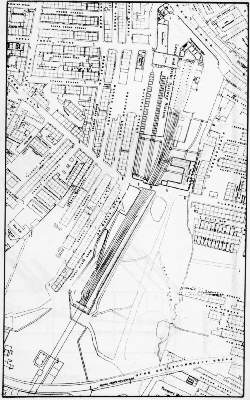
Click for zoomed-in detail map
The identity of X.Y.Z. remains unknown although many suspect he was John Blenkinsop himself. X.Y.Z clearly has detailed knowledge of the Blenkinsop locomotive system, and Blenkinsop was well known as a promoter of railways.
Two more letters were published in October. One was from a vessel owner who rants against the mill owners for stealing water from the lock system, and also described the idea of a railway as absurd. The second from "A FRIEND TO TRADE" suggested a meeting to discuss the various ideas proposed in the previous letters. That was the end of the correspondence, and X.Y.Z's enthusiasm for a railway linking Leeds to Selby failed to attract any support from the businessmen of Leeds at that time.
The concept came back in 1821 when a route from Leeds to Hull via Selby was proposed. George Stephenson prepared a survey that used rope-hauled inclines connected by level sections with horse or locomotive haulage. This scheme received very little support.
A canal was built linking Knottingley to Goole in 1826, with the effect that Selby and Hull lost traffic to the inland port at Goole. The Leeds to Hull railway scheme was proposed again in 1829. Inclined planes had been superceded by this time, and the new scheme was entirely locomotive hauled. By the time it was passed by Parliament in July 1930, it was shortened to only run from Leeds to Selby. Steam packet ships would carry traffic between Selby and Hull. The new scheme was surveyed by James Walker who noted that his railway route was 20 miles, compared to the water route of 30 miles with nine sets of locks. Valuable goods were already being sent by road, and Walker expected the railway to replace this turnpike traffic before it replaced the canal traffic. Walker also made note of the many mines and quarries along his proposed route. The scheme was also helped by the fact that most of the land it crossed was owned by four directors of the company! One of these landowners, Richard Oliver Gascoigne, particularly wanted the new railway to cross his land so that he could use it to carry coal from his collieries.
Although the Act of Parliament suggested a single track with three passing places, land was purchased and bridges were built to accommodate four lines. The first construction contracts were let in September 1830 to Nowell & Sons of Dewsbury, and Hamer & Pratt of Goole. Nowell & Sons worked on the western stretch between Leeds and Osmondthorpe. This included the Marsh Lane tunnel and cuttings which claimed many lives.
Both contractors had labour problems, especially during harvest season when the navvies preferred to the more lucrative farm work. A source of stone sleeper blocks also proved a problem. The intention was to quarry these from the railway cuttings near Crossgates, but this stone proved inadequate for the task. Limestone from Huddlestone was tried, but the problem was eventually solved using stone from the Bramley Hill Quarries (west of Leeds). Delays were also experienced due to embankment earthslips, and the discovery of lost colliery workings.

Click for zoomed-in detail map
The railway was finally opened to the public on 22nd September 1834. The opening was quite an event, with 20,000 people turning out at 6:30am to watch the first train leave the terminus at Leeds Marsh Lane. The idea of using horses had been abandoned by this stage, and the first train was hauled by Fenton, Murray & Jackson's Nelson. This first train did not have a successful start. It had been raining that morning, and Nelson's wheels started to slip on the climb up Richmond Hill and through Marsh Lane tunnel. The fireman put ashes on the rails to let the wheels grip, but it would take 7 minutes for the engine to emerge from the Marsh Lane tunnel. One of the three coaches was uncoupled to help, but it still took Nelson 70 minutes to reach Manston. Much jeering from the crowd was reported. By the time Nelson reached Garforth, the weather was improving and the train picked up a good speed of 20mph downhill towards Selby. The train arrived just before 9am and set off to Leeds after a wait of two hours. The return journey was much swifter, reaching Marsh Lane in 76 minutes. A crowd of 40,000 were waiting for the train's return.
Despite these problems, the new railway revolutionised travel between Leeds and Selby. Previously, summer stagecoach traffic consisted of about 400 people per week. The railway carried an average of 3,500 passengers per week throughout the summer of 1835. The Leeds and Selby was one of the first railways in the world to offer excursion trains in 1838. By 1840, connections were shared with the newly opened Hull & Selby Railway and the York & North Midland Railway.
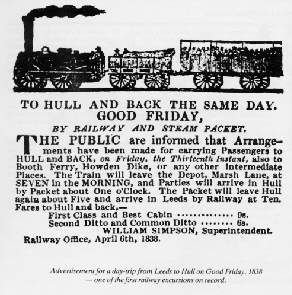
| Top | Early History | George Hudson | NER & LNER | Route Today | Further Reading |
George Hudson
The Leeds & Selby (L&SR) was joined to the York & North Midland Railway (Y&NMR) when it opened on 1st July 1840. This was owned by George Hudson, the "Railway King". With the North Midland Railway (NMR) connecting the L&S Railway with a curve from Methley Junction (NMR) to Whitwood Junction (L&SR); Hudson could compete with the L&SR between Leeds and the Y&NMR junction at Milford. Passengers clearly preferred the L&SR route as it was over 4 miles shorter, and did not require a change of train. Hudson recognised the threat that the L&SR posed, and offered them a lease that they could not refuse. The lease of £17,000 per year added the L&SR to Hudson's quickly growing empire before the end of 1840.
Hudson could now choose the passenger route, and he quickly withdrew all passenger services on the L&SR between Leeds and Milford. Hudson's lease lasted four years until he purchased the L&SR outright in 1844. Thus, the L&SR independence lasted a short ten years. Freight traffic was quickly stopped after the purchase was completed. The isolated position of the Marsh Lane terminus was given as the main reason for these traffic restrictions, although this would have only affected freight traffic passing through Leeds.
The railway share bubble was bursting by the end of 1847, forcing Hudson to resign from many of his companies and directorships. Being forced to pay back various bribes and insider investment advice, Hudson's downfall was rapid. This would eventually include a spell in York Castle as a debtor.
With the end of the Hudson empire, the owning Y&NMR reinstated passenger traffic over the full length of the L&SR in 1850. This was followed by freight traffic a few months later.
| Top | Early History | George Hudson | NER & LNER | Route Today | Further Reading |
NER & LNER
The second half of the 19th century was a period of consolidation for the British railway industry. The Y&NMR, was purchased by the growing North Eastern Railway (NER) in 1854.
The NER became a part of the newly formed LNER with Grouping on 1st January 1923. The LNER became a part of the nationalised British Railways on 1st January 1948.
The line's franchise is currently operated by Northern Rail, with financial support from the West Yorkshire Passenger Transport Executive for the stations in the Leeds area.
(this section will be expanded in the future)
| Top | Early History | George Hudson | NER & LNER | Route Today | Further Reading |
The Route Today
The Leeds & Selby railway is still open to traffic, and follows virtually the same route. Stations have opened and closed, and the Marsh Lane tunnel has been opened out.

Leeds
The Marsh Lane terminus has been closed, and the route continues to the modern Leeds City station. Leeds City was originally built in 1869 but was rebuilt during the 1960s when the Leeds Central station was closed and the services were combined at Leeds City. It was recently refurbished.
Marsh Lane
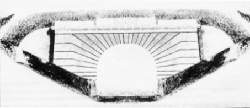
The construction of the Marsh Lane cutting and tunnel through Richmond Hill led to the loss of many lives. The tunnel quickly gained a bad reputation due to locomotive smoke and darkness. Whitewash and copper reflectors were added to improve lighting. Eventually the line was widened and the tunnel opened out in 1894. This was primarily to allow increased traffic movements after Neville Hill engine sheds were expanded.
The opening out of the tunnel resulted in the most impressive civil engineering along the line, with a deep cutting and a series of impressive cross bridges.

A station was originally located on the west side of the tunnel at Marsh Lane. This closed in 1958. The original terminus was just to the north.
Neville Hill depot is located just north of the line, east of the cutting.
Osmondthorpe
A station was opened on 29th September 1930 to serve a new housing estate. This closed on 7th March 1960. There have been plans to re-open it during the past 10-20 years, but this has yet to occur.
The line's highest embankment is located to the west of the old station. This includes the original bridge over Selby Road which was built to be wide enough to carry four tracks. Unfortunately the span was not built with as much fore-thought, and it is now a significant bottleneck for road traffic.

Click for zoomed-in detail map

Cross Gates
Cross Gates was initially considered for the joint LNER-LMS locomotive testing station, before Rugby was chosen. At its peak, Cross Gates had four through lines, a junction to Wetherby, and various goods sidings. Dedicated sidings also existed to serve local collieries and the Royal Ordnance Factory at Barnbow.
The station at Cross Gates is still open to the public. The route to Wetherby was the first railway to be closed under Beeching's infamous axe, and its cutting can still be seen from the station platforms. The Arndale Shopping Centre is now located on the old goods yard. The Royal Ordnance Factory was purchased by Vickers Defence Systems but has recently closed.
Garforth

Garforth was an important station for the Leeds & Selby, due to the large number of collieries in the area. It was also the junction for Richard Oliver Gascoigne's Aberford Railway. As well as carrying coal from his local collieries, this private railway carried passengers from 1835 to 1924.
The skew bridge crossing the main Garforth station was hailed as a wonder of the new railway age when it was built.
Garforth is now an important commuter station for Leeds. Commuter traffic has proven sufficient for a second station at East Garforth to be opened in the late 1980s.
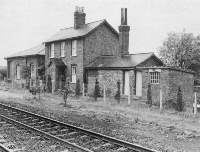
Micklefield
There is still a station located at Micklefield. The original station master's house, porters room, and early goods warehouse have been preserved.
Micklefield is also the location of the junction with the spur towards York.
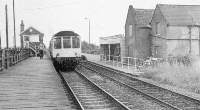
South Milford
South Milford station also survives, complete with a low platform on one side.
After South Milford, the line rises to cross the York & North Midland Railway route which also survives. Originally known as Milford Old Junction, the area has been referred to as Gascoigne Wood throughout much of the 20th century. With the development of the Selby Coalfield, the area saw much redevelopment during the 1980s.
Hambleton Station
Hambleton Station closed in September 1959. Today, it is the location of the line's newest junction. Opened in 1983, the Selby Diversion crosses the Leeds & Selby at Hambleton. This high speed diversion of the East Coast Mainline was built to avoid subsidence due to the Selby Coalfield development.
Thorpe Willoughby & Brayton Gates
A direct link with Goole joined the line at Thorpe Willoughby between 1910 and 1945. The small independent Cawood, Wistow & Selby Light Railway joined at Brayton Gates. The NER never granted them access to Selby station, and passengers had to alight at the junction. Brayton Gates station closed to passengers on 31st December 1929, and goods on 23rd May 1960.
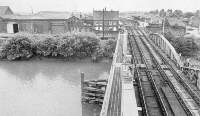
Selby
In Selby the present line diverts slightly to the south of the original. The present Selby station has lost much of its importance due to the diversion of the East Coast Mainline, and closure of the Market Weighton line.
The original 1834 buildings survive despite being only used for six years of passenger service. The station master's house is on the south side near the swing bridge. The original terminus survives. Built as a simple cover over six tracks, it was built with no raised platforms and no waiting rooms. Underground water tanks stored rainwater for locomotive use.
Further Reading
The following pages within the LNER Encyclopedia provide more detail about related subjects:
The following resources were used in the writing of this page, and are recommended for people looking for further information.
Online
-
Timothy Owston has a good
biography of George Hudson.
- Northern Rail are the current franchise holders for services along the
Leeds & Selby Railway.
- MetroTrain is the brand used by the West Yorkshire Passenger
Transport Executive for the services that they sponsor along the Leeds & Selby route, as well as other routes.
- The Aberford Railway and the History of the Garforth Collieries, by Graham S. Hudson
concentrates on the Gascoigne family, as well as the coal and rail operations in the Garforth area. This includes
the planning and development of various long distances schemes through the area including the Leeds & Selby Railway,
and the York & North Midland Railway.
-
A Regional History of the Railways of Great Britain, Vol. 4 The North East by K. Hoole includes a description of
George Hudson and the Leeds & Selby Railway.
-
Yorkshire's First Main Line was published by the West Yorkshire Metropolitan County Council in 1984 to celebrate
the 150th anniversary of the Leeds & Selby Railway.
Acknowledgements
Sheila Bye, Historian/Archivist of the Middleton Railway Museum was particularly helpful with The Leeds Mercury correspondence.
| Top | Early History | George Hudson | NER & LNER | Route Today | Further Reading |